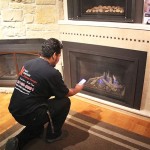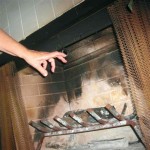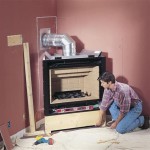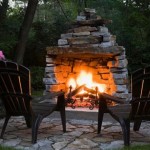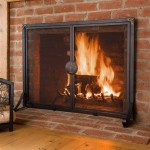Art Deco Fireplace Hearths: A Study in Geometric Elegance and Functional Design
Art Deco, a prominent design movement of the 1920s and 1930s, profoundly influenced architecture, decorative arts, and interior design. Its aesthetics, characterized by geometric shapes, stylized ornamentation, and luxurious materials, found expression in various elements of the home, including the fireplace hearth. The Art Deco fireplace hearth represents a departure from the more ornate and organic styles of previous eras, embracing a modern sensibility that prioritized streamlined forms and sophisticated detailing. These hearths served not only as functional components but also as focal points, reflecting the era's fascination with modernity, progress, and the machine age.
The design principles of Art Deco fireplace hearths reflected the broader tenets of the movement. Symmetry, clean lines, and geometric patterns were central to their aesthetic. Common motifs included chevrons, zigzags, sunbursts, and stepped forms. These shapes were often repeated and arranged in symmetrical patterns, creating a sense of order and visual harmony. In contrast to the sometimes cluttered and asymmetrical designs of earlier periods, Art Deco prioritized clarity of form and a sense of controlled elegance. The emphasis on geometry extended to the overall shape of the hearth, which was often rectangular or square, with sharp, defined edges. Curves were used sparingly, typically in a stylized and controlled manner, rather than in the flowing, organic forms of Art Nouveau. This geometric rigor contributed to the overall impression of modernity and sophistication that defined the Art Deco style.
Materials played a crucial role in defining the character of Art Deco fireplace hearths. The selection of materials frequently reflected the era's taste for luxury and modernity. Marble, particularly varieties with bold veining and contrasting colors, was a popular choice. Black marble, often paired with white or cream-colored marble, created a striking visual contrast that exemplified the Art Deco aesthetic. Other favored materials included polished stone, such as granite and travertine, as well as metal accents, such as chrome, nickel, and brass. These metallic elements were often used to trim the hearth, frame the firebox opening, or create decorative details. The combination of natural stone and polished metal contributed to the overall sense of opulence and sophistication. Furthermore, the use of new and innovative materials, such as Bakelite and other early plastics, reflected the era's fascination with technological progress. While less common in hearth construction itself, these materials might be incorporated into surrounding decorative elements or accessories, further enhancing the Art Deco ambiance.
The Geometric Vocabulary of Art Deco Hearths
The defining characteristic of an Art Deco fireplace hearth is its embrace of geometric shapes and patterns. This emphasis on geometry manifested in several key ways. The overall shape of the hearth itself was frequently rectangular or stepped, with clean, sharp lines and a symmetrical arrangement. The use of curved lines was generally minimal, although stylized curves were sometimes incorporated into decorative details. For example, a hearth might feature a stepped front with a gently curved top edge, or a series of concentric arcs radiating outwards from the firebox opening. However, even these curved elements were carefully controlled and integrated into the overall geometric framework.
Specific geometric motifs were repeated throughout Art Deco design, and these motifs were prominently featured in fireplace hearths. Chevrons, zigzags, and stepped patterns were common elements. These patterns were often created using contrasting colors of marble or other materials, further enhancing their visual impact. Sunburst motifs, representing the dawn of a new era, were also frequently incorporated into hearth designs. These sunbursts might be represented as stylized rays emanating from a central point, or as concentric circles of radiating patterns. The repetition of these geometric motifs created a sense of order and visual rhythm, contributing to the overall impression of streamlined elegance. Furthermore, the use of symmetry was paramount. Art Deco hearths were typically designed with a central axis of symmetry, ensuring a balanced and harmonious composition. This symmetry reinforced the sense of order and control that characterized the style.
The patterns were not merely decorative; they often served to accentuate the architectural features of the hearth and the surrounding space. For example, a series of vertical lines might be used to emphasize the height of the hearth, while horizontal lines could visually broaden the space. Stepped patterns, in addition to their decorative appeal, could also be used to create a sense of depth and dimension. The strategic use of these geometric elements allowed designers to create hearths that were both visually appealing and architecturally integrated into the surrounding environment.
The Role of Materials in Achieving the Art Deco Aesthetic
The selection of materials was crucial to achieving the distinctive look of an Art Deco fireplace hearth. The materials commonly used reflected the era's taste for luxury, modernity, and technological innovation. Marble was a particularly popular choice, prized for its natural beauty, durability, and ability to be polished to a high sheen. Different varieties of marble were used, often in contrasting colors, to create visually striking patterns and textures. Black marble, frequently paired with white or cream-colored marble, was a classic combination that epitomized the Art Deco aesthetic. The bold veining and contrasting shades of these marbles added depth and visual interest to the hearth design.
In addition to marble, other polished stones, such as granite and travertine, were also commonly used. These stones offered similar qualities of durability and visual appeal, while also providing a wider range of colors and textures. Granite, with its speckled appearance, could add a subtle textural contrast to the smooth, polished surfaces of the hearth. Travertine, with its characteristic porous texture, could bring a sense of warmth and naturalness to the design. The choice of stone depended on the overall aesthetic goals of the designer and the specific characteristics of the surrounding space.
Metal accents were also an integral part of the Art Deco hearth. Chrome, nickel, and brass were commonly used to trim the hearth, frame the firebox opening, and create decorative details. These metals provided a sleek, modern counterpoint to the natural stone, adding a touch of industrial chic to the design. The metallic elements were often polished to a high gloss, reflecting light and adding a sense of glamour. In some cases, metal inlays were used to create geometric patterns or stylized motifs, further enhancing the Art Deco aesthetic. The combination of natural stone and polished metal created a dynamic interplay of textures and materials, contributing to the overall impression of opulence and sophistication.
Functionality Meets Artistry: Design Considerations for Art Deco Hearths
While aesthetics were paramount in Art Deco design, functionality was also an important consideration. An Art Deco fireplace hearth was not merely a decorative element; it also had to function effectively as a fire surround, providing a safe and efficient way to contain and manage the heat of the fire. This required careful attention to the dimensions of the hearth, the design of the firebox opening, and the selection of materials that could withstand high temperatures. The size of the hearth had to be proportionate to the size of the room and the scale of the fireplace. A hearth that was too small would appear insignificant, while a hearth that was too large would overwhelm the space. The dimensions of the firebox opening had to be carefully considered to ensure proper ventilation and prevent smoke from escaping into the room. Fire-resistant materials, such as brick or fire-rated stone, were typically used to line the firebox and the back of the hearth, providing protection from the intense heat of the fire.
The design of the hearth also had to take into account the practical considerations of cleaning and maintenance. Smooth, polished surfaces were preferred, as they were easy to wipe clean and resistant to staining. The use of intricate carvings or textured surfaces was generally avoided, as these could trap dust and dirt. The hearth was typically designed with a slight slope or lip to prevent embers or ash from spilling onto the floor. Careful attention was also paid to the placement of the hearth in relation to other elements of the room, such as furniture and doorways. The hearth was typically positioned to create a focal point in the room, drawing the eye and creating a sense of warmth and comfort. However, it also had to be positioned in a way that did not obstruct traffic flow or create a fire hazard.
Furthermore, the Art Deco fireplace hearth often integrated storage space for firewood or other fireplace accessories. This storage was typically concealed behind doors or panels that were seamlessly integrated into the overall design of the hearth. The doors or panels were often adorned with geometric patterns or stylized motifs, further enhancing the Art Deco aesthetic. The integration of storage space allowed for a more streamlined and organized appearance, contributing to the overall sense of order and sophistication that characterized the style. In conclusion, the design of an Art Deco fireplace hearth required a careful balance between aesthetics, functionality, and practicality. The best examples of these hearths are those that seamlessly integrate these elements, creating a focal point that is both visually appealing and functionally effective.

Art Deco Fireplaces In Leeds Classic

Wyndham Art Deco All Tiled Fireplace Westcombes

Wyndham Art Deco All Tiled Fireplace Twentieth Century Fireplaces

The Hulanicki Art Deco Style Fireplace Surround

Art Nouveau Deco Fireplaces

Fireplacing In The Home Art Deco Living Room Fireplace Stone Designs

Art Deco Fireplace Hearth Natural Stone Traditional Cheshire By Rockford Company Houzz

Art Nouveau Tiled Convector Fireplaces Stovax

Art Nouveau Tiled Convector Fireplaces Stovax

Keaton Art Deco Marble Fireplace Twentieth Century Fireplaces Interior Architecture
Related Posts

